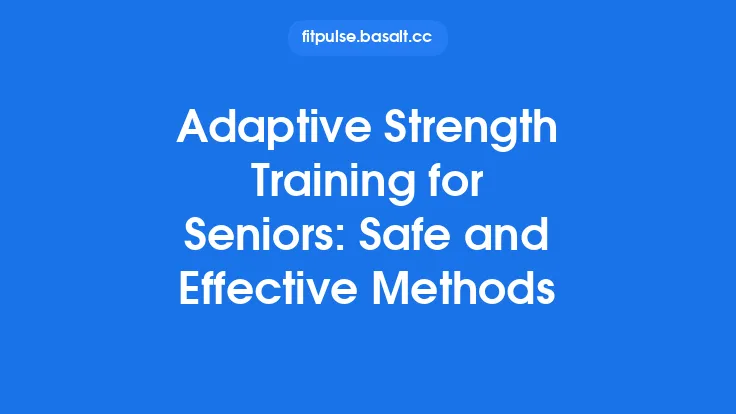The years after retirement often bring more free time, but they can also bring subtle shifts in the body that make everyday movements feel harder or less comfortable. While many seniors assume that stretching and mobility work are only for athletes or younger adults, a well‑designed, safety‑first approach to stretching can be a cornerstone of long‑term health, helping to preserve joint health, maintain circulation, support bone density, and keep the nervous system responsive. Below is a comprehensive guide that walks you through the essential concepts, practical techniques, and everyday strategies for safe stretching and movement that promote longevity.
Understanding Age‑Related Changes in the Musculoskeletal System
1. Tendon and Ligament Stiffness
With age, collagen cross‑linking increases, making tendons and ligaments less pliable. This can reduce the range of motion (ROM) and increase the risk of strains if a stretch is performed too aggressively.
2. Cartilage Thinning and Joint Space Reduction
Articular cartilage gradually loses water content, leading to thinner cartilage layers and narrower joint spaces. The result is a lower tolerance for high‑impact or extreme positions.
3. Muscle Mass Decline (Sarcopenia)
From the third decade onward, muscle protein synthesis slows, and muscle fibers shrink. By the seventh decade, many seniors have lost 30‑40 % of their muscle mass, which directly impacts the ability to generate force during both stretching and functional movements.
4. Decreased Proprioceptive Sensitivity
Aging nerves transmit less precise information about joint position, making it harder to gauge safe stretch limits without visual or tactile cues.
5. Bone Density Changes
Osteopenia and osteoporosis reduce the structural support around joints, meaning that excessive loading or extreme joint angles can increase fracture risk.
Understanding these physiological shifts is the first step toward designing a stretching routine that respects the body’s current capabilities while gently encouraging improvement.
Core Principles of Safe Stretching for Seniors
| Principle | What It Means for You | Practical Tip |
|---|---|---|
| Gradual Progression | Increase stretch intensity in small increments (e.g., 5 % per week). | Use a “pain‑scale” of 0–10; aim for a 2–3 rating (mild stretch) and never exceed 5 (moderate discomfort). |
| Controlled Range | Avoid “ballistic” or bouncing movements that can overload joints. | Hold each stretch for 20–30 seconds, then release slowly. |
| Balanced Antagonist Work | Stretching one muscle group without addressing its opposing group can create imbalances. | Pair hamstring stretches with gentle quadriceps lengthening, and chest stretches with upper‑back mobilizations. |
| Breath‑Linked Movement | Proper breathing helps relax the nervous system and improves tissue extensibility. | Inhale to prepare, exhale while gently deepening the stretch. |
| Joint‑Centric Focus | Keep the joint as the central point of the stretch, not the surrounding muscle alone. | Visualize the joint “hinge” moving within its natural arc. |
| Individualized Limits | Every senior’s baseline differs; personal history (e.g., arthritis, surgeries) dictates safe boundaries. | Conduct a brief self‑assessment or consult a health professional before starting. |
Selecting Appropriate Stretch Types and Modifications
| Stretch Type | Typical Use | Senior‑Friendly Modification |
|---|---|---|
| Static Stretch | Holding a position to lengthen a muscle. | Perform seated or supported versions; use a pillow under the knee for hamstring stretches. |
| Dynamic Stretch | Moving through a controlled range to warm tissues. | Limit the amplitude; for example, perform slow leg swings while holding onto a chair for balance. |
| PNF (Proprioceptive Neuromuscular Facilitation) | Involves a brief contraction followed by a deeper stretch. | Use “contract‑relax‑assist” with a partner or therapist; keep contractions light (10‑15 % of maximal effort). |
| Myofascial Release (Self‑Massage) | Targets connective tissue adhesions. | Use a soft foam roller or a tennis ball against a wall, applying only light pressure. |
| Isometric Stretch | Holding a muscle contraction without changing joint angle. | Sit upright, press the back of the thigh into a chair while maintaining a neutral spine for 5‑10 seconds. |
Key Modification Strategies
- Supportive Surfaces: Use chairs, benches, or sturdy tables to reduce load on weight‑bearing joints.
- Prop Utilization: Place yoga blocks, rolled towels, or cushions under limbs to achieve a comfortable stretch angle.
- Reduced Load: Perform stretches with the non‑stretched limb bearing most of the weight (e.g., one‑legged calf stretch while the other leg supports the body).
- Temperature Consideration: Warm the muscles with a light walk or a warm shower before stretching; cold muscles are more prone to injury.
Functional Movement Patterns That Support Longevity
While isolated stretches improve tissue length, integrating movement patterns that mimic daily tasks reinforces joint health and neuromuscular coordination.
- Hip Hinge for Safe Bending
- Why: Protects the lumbar spine and maintains hip flexibility.
- How: Stand with feet hip‑width apart, place a light kettlebell or a small bag in front of you, hinge at the hips while keeping a neutral spine, and return to standing. Perform 8‑10 repetitions.
- Sit‑to‑Stand Transition
- Why: Enhances quadriceps strength, knee joint range, and core stability.
- How: From a seated position, push through the heels, engage the glutes, and rise fully before sitting back down. Use a sturdy chair with armrests for added safety.
- Wall‑Supported Marching
- Why: Improves ankle dorsiflexion and gait mechanics without excessive load.
- How: Stand facing a wall, place hands lightly on it for balance, and lift each knee to a comfortable height, alternating sides for 30‑seconds.
- Thoracic Rotation with a Chair
- Why: Maintains upper‑back mobility essential for reaching and turning.
- How: Sit sideways on a chair, cross arms over the chest, and rotate the torso toward the back of the chair, holding briefly before returning. Perform 5‑6 repetitions each side.
These patterns can be performed in short “micro‑sessions” throughout the day, ensuring that mobility work is woven into everyday life rather than isolated to a single workout block.
Integrating Mobility Into Daily Life
- Morning Routine (5 minutes): After getting out of bed, perform seated ankle circles, neck rotations, and a gentle seated cat‑cow stretch while still on the mattress.
- Mid‑Day Break (3 minutes): While watching TV or during a commercial break, stand and do a wall‑supported calf stretch, followed by a brief chest opener using a doorway.
- Evening Wind‑Down (7 minutes): Prior to bedtime, sit on a sturdy chair and perform a seated hamstring stretch, followed by a supine knee‑to‑chest stretch on the floor or a firm mattress.
By distributing short bouts of movement across the day, seniors can maintain joint lubrication, improve circulation, and reduce stiffness without feeling overwhelmed.
Monitoring Progress and Recognizing Red Flags
Self‑Assessment Checklist (Weekly)
- Range of Motion: Can you comfortably reach a 90‑degree knee bend without pain?
- Pain Level: Do any stretches consistently score above 4 on the 0‑10 discomfort scale?
- Joint Stability: Do you feel any “giving way” sensation during functional movements?
- Recovery: Are you experiencing prolonged soreness (>48 hours) after a session?
Red Flags Requiring Professional Attention
- Sharp, localized joint pain during or after a stretch.
- Swelling, redness, or warmth around a joint.
- Sudden loss of balance or frequent falls.
- New onset of numbness or tingling in the limbs.
If any of these symptoms appear, pause the routine and consult a healthcare provider or a qualified physical therapist before resuming.
Role of Supportive Tools and Environments
| Tool | Best Use for Seniors | Safety Note |
|---|---|---|
| Resistance Bands (light‑to‑medium tension) | Gentle assisted stretches for shoulders, hips, and hamstrings. | Inspect for cracks before each use; replace if frayed. |
| Foam Rollers (soft density) | Myofascial release on larger muscle groups (e.g., calves, thighs). | Avoid rolling directly over bony prominences; keep pressure light. |
| Yoga Blocks or Firm Pillows | Elevate hands during forward bends or support knees during seated stretches. | Ensure blocks are stable and won’t slip on smooth floors. |
| Non‑Slip Mats | Provide a stable surface for floor‑based stretches. | Keep the mat clean and dry to prevent slipping. |
| Adjustable Chairs with Armrests | Support for seated stretches and functional movements like sit‑to‑stand. | Verify that the chair is sturdy and does not wobble. |
Creating a safe environment—clear of clutter, with adequate lighting, and with supportive surfaces—reduces the risk of accidental falls and encourages confidence during mobility work.
Nutrition and Lifestyle Factors That Complement Mobility
- Protein Intake: Aim for 1.0–1.2 g of high‑quality protein per kilogram of body weight daily to support muscle repair and synthesis. Sources include lean poultry, fish, legumes, and dairy.
- Vitamin D & Calcium: Essential for bone health; consider fortified foods or supplements after discussing with a physician.
- Hydration: Dehydrated connective tissue loses elasticity. Aim for at least 1.5–2 L of water per day, adjusting for climate and activity level.
- Anti‑Inflammatory Foods: Incorporate omega‑3‑rich fish, nuts, berries, and leafy greens to help manage low‑grade inflammation that can limit mobility.
- Adequate Sleep: 7–8 hours of restorative sleep each night supports tissue recovery and hormonal balance.
When nutrition and lifestyle align with a safe stretching routine, the synergistic effect can significantly enhance joint health and overall longevity.
Frequently Asked Questions (FAQ)
Q1: How often should I stretch each week?
A: For most seniors, 3–4 sessions per week, each lasting 10–15 minutes, provide sufficient stimulus without overloading the tissues.
Q2: Is it safe to stretch if I have mild osteoarthritis?
A: Yes, provided the stretches stay within a pain‑free range and avoid deep joint compression. Low‑impact static stretches and gentle dynamic movements are generally well‑tolerated.
Q3: Can I use a yoga strap for hamstring stretches?
A: Absolutely. A yoga strap or a sturdy belt can help maintain a neutral spine while gently pulling the leg toward you, reducing strain on the lower back.
Q4: Should I stretch before or after a walk?
A: Light dynamic movements before a walk (e.g., leg swings) can prepare the muscles, while static stretches after the walk help maintain length and reduce post‑exercise stiffness.
Q5: What if I feel a “twinge” during a stretch?
A: A mild, fleeting sensation is often normal, but if the feeling persists or turns into sharp pain, stop the stretch immediately and reassess your technique or range.
Closing Thoughts
Safe stretching and purposeful movement are not luxury activities reserved for the young or the ultra‑fit; they are essential tools for seniors who wish to preserve independence, reduce discomfort, and enjoy a higher quality of life well into their later years. By respecting age‑related physiological changes, adhering to core safety principles, selecting appropriate stretch modalities, and embedding mobility into everyday routines, seniors can build a resilient musculoskeletal system that supports longevity.
Remember, the journey is personal—listen to your body, progress gradually, and seek professional guidance when needed. With consistent, mindful practice, the simple act of stretching can become a powerful ally in the pursuit of a vibrant, active, and healthy senior life.





